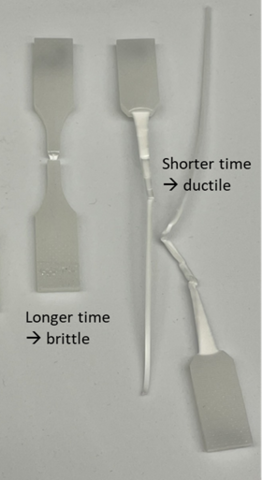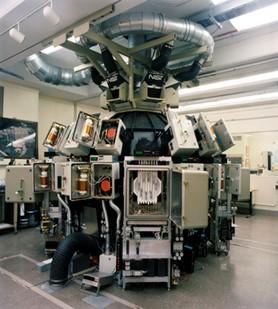Weathering Plastic Waste with the NIST SPHERE
Jump to a section
Introduction

Every year, increasing quantities of plastic waste end up in the environment, especially in bodies of water. A major problem with plastic waste accumulation in the environment is that there remain many unknown impacts of degraded plastic waste on the environment and human, health. Plastics are made of a variety of materials (types and formulations), meaning that they may degrade at different rates and affect the environment in different ways. In addition, better methods are needed to test the risks that different types of plastic particles may pose.
The Weathering Plastic Waste with the NIST SPHERE project systematically accelerates the environmental aging of plastic waste using the state-of-the-art NIST SPHERE. Weathered plastic generated using the NIST SPHERE will be evaluated with different instrumentation to accurately identify the degraded material and measure the impact of weathered plastic waste on the environment. Toxicity methods are also being developed to understand if weathered plastic particles can cross the human gut tract in a cell-based model.
Contribution to a circular economy

This project is part of NIST's Circular Economy Program, which supports the nation’s need to transition away from a model in which materials are extracted from the environment, manufactured into products, used, then discarded (a so called “linear economy”) toward one in which the materials that make up those products repeatedly cycle within the economy and retain their value.
One goal is to generate systematically degraded plastic particles for use as Research Grade Test Materials (RGTM). RGTMs will enable researchers to investigate the environmental impacts of plastic waste in a consistent manner. Alongside RGTM development, data will be provided to indicate how quickly certain plastics degrade, what secondary products are produced during degradation, and toxicity data with selected assays. Fourier-transform infrared (FT-IR) spectra of weathered plastics will also be added to a database so weathered plastic waste in the environment can be more easily identified.
Why is NIST doing this work?
Learn more
- You can learn about the NIST SPHERE here.
- If you are interested in the results of our weathering and toxicity research, see our publications below. Stay tuned for more results.
Our Team

NIST Collaborators




Publications
- Rostampour, S.; Jhang, S.S.; Hsu, J.-K.; Cook, R.; Li, Y.; Fan, C.; Sung, L.-P. Evaluating the Environmental Factors on Microplastic Generation: An Accelerated Weathering Study. Microplastics 2025,4,13. https://doi.org/10.3390/microplastics4010013
- S. Rostampour, R. Cook, S.-S. Jhang, Y. Li, C. Fan, L.-P. Sung, “Changes in the Chemical Composition of Polyethylene Terephthalate Under UV Radiation in Various Environmental Conditions,” Polymers (2024) 16, 2249. https://doi.org/10.3390/polym16162249
- D.G. Goodwin Jr, S-J Shen, Y. Lyu, R. Lankone, A.C. Barrios, S. Kair, F. Perreault, W. Wohlleben, T. Nguyen, L. Sung, “Graphene/Polymer Nanocomposite Degradation by Ultraviolet Light: The Effects of Graphene Nanofillers and their Potential for Release Polymer Degradation and Stability,” Polym. Degrad. Stab., (2020) 182, 109364
- J.E. Pickett, O. Kuvshinnikova, L.-P. Sung, B. Ermi, “Accelerated Weathering Parameters for Some Aromatic Engineering Thermoplastics. Part 2: Polycarbonate copolymers, polyarylate and ABS,” Polym. Degrad. Stab. (2020) 181, 109330.
- H.-C. Hsueh, J.H. Kim, S. Orski, A. Fairbrother, D. Jacobs, L. Perry, D. Hunston, C. White, L. Sung, Micro and macroscopic mechanical behaviors of high-density polyethylene under UV irradiation and temperature,” Polym. Degrad. Stab. (2020) 174, 109098.
- A. Fairbrother, H.-C. Hsueh, J.H. Kim, D. Jacobs, L. Perry, D. Goodwin, C. White, S. Watson, L.-P. Sung, “Temperature and light intensity effects on photodegradation of high-density polyethylene,” Polym. Degrad. Stab. (2019) 165 153-160.
- J.E. Pickett, O. Kuvshinnikova, L.-P. Sung, B. Ermi, “Accelerated weathering parameters for some aromatic engineering thermoplastics,” Polym. Degrad. Stab. (2019) 166, 135-144.
- Elliott, J. T., Rosslein, M., Song, N. W., Toman, B., Kinsner-Ovaskainen, A., Maniratanachote, R., Salit, M. L., Petersen, E. J., Sequeira, F., Lee, J., Kim, S. J., Rossi, F., Hirsch, C., Krug, H. F., Suchaoin, W., Wick, P. Toward achieving harmonization in a nano-cytotoxicity assay measurement through an interlaboratory comparison study, Altex, (2017) 34(2), 201-218.
- Hanna, S., Montoro Bustos, A., Peterson, A. W., Reipa, V., Scanlan, L. D., Hosbas Coskun, S., Cho, T. J., Johnson, M. E., Hackley, V. A., Nelson, B. C., Winchester, M. R., Elliott, J. T., Petersen, E. J. Agglomeration of Escherichia coli with positively charged nanoparticles can lead to artifacts in a standard Caenorhabditis elegans toxicity assay, Environmental Science and Technology, (2018) 52(10), 5968-5978.
Contacts
Team Lead
-
(301) 975-6737
Team Members
-
(301) 975-8142
-
(301) 975-0502




